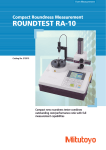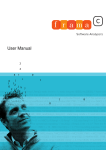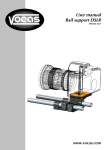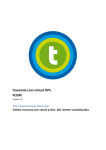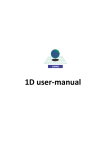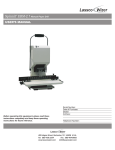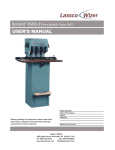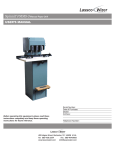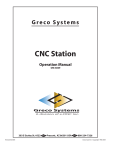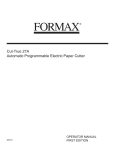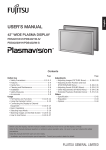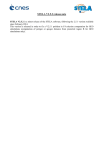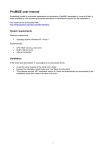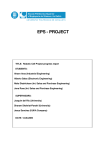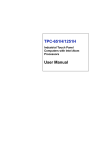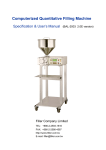Download RW bending Product descrip. ENG
Transcript
Version: 1.2 Last Update: July 2014 Product Description BENEFITS 7 1. BENEFITS AND ADVANTAGES FOR SYSTEM INTEGRATORS 7 I. TECHNICAL FUNCTIONALITY 8 1 PIECE IMPORT AND CORRECTION 8 2. BEND TYPES 8 3. THE PRESS-BRAKE TOOLS 8 4. THE ROBOT TOOLS 10 5. BACK GAUGES AXES CONFIGURATIONS 11 6. AUTOMATIC BENDING: THE AUTOMATIC BENDING PROCESS 11 7. THE CELL LAYOUT 13 8. ROBOT TRAJECTORY GENERATION AND SIMULATION 14 II. PRODUCT STRUCTURE AND SOFTWARE ENVIRONMENTS 15 1 EDITING 16 2 2. PROGRAMMING AND SIMULATION 19 3. POST PROCESSING 23 4. INTEGRATION WITH EXTERNAL SOFTWARE 26 III. PRODUCT ACCESS LEVELS 27 IV. PRODUCT ARCHITECTURE AND OPENESS 28 1. THE ADD-INS 28 2. THE KIT ADD-INS 29 V 31 PRODUCT DISTRIBUTION 3 In the last years, robotics has adapted itself continually to markets becoming always more exigent, different and oriented to software solution highly customized, that need important investments and long time development. Traditional programming software allow to program robot and working process, using learning methods that are long and complex and causing production stops. Otherwise, an intelligent off-line programming is able to automatically generate the optimized production sequence, without stopping the plant. 4 RoboWave bending is the complete solution, dedicated to robotized bending process, that allows to program robot and press-brake – from picking to stacking management – at the office without stopping the production plant: automatic bending sequence definition, tools set-up and gauges positioning, robot trajectories generation, are performed in a rapid and reliable way. RoboWave bending is part of the software solutions offer, developed on the powerful RoboWave platform. RoboWave is a simulation tool, standard, open and customizable, suitable for System Integrators. RoboWave bending incorporates the 20 years loger experience and know-how in robotics and bending application. The software may be installed on a workstation in the plant or in the office, decreasing dramatically robot set-up and programming time. RoboWave bending is easy-to-use also for not experts in robotics applications. Piece importer Piece Off-line Programming Robot post-processor Robot part program Press-brake post-processor Press-brake part program RoboWave bending is perfectly customizable and allows to define all parameters of the bending process as the bending sequence, the press-brake tools, the back-gauge position, etc. to generate the robot movements. 5 The complete bending process is defined through the simulation of the robot and press brake cycle, verifying step by step the correctness of the part program in terms of robot working area, collisions and reachability. RoboWave bending allows to build very easily every cell elements and to define cell layout, through innovative and independent 3D environments, verifying the correct position of elements and optimizing it in function of production requirements and space limitations. Bending sequence and robot movements are automatically generated, considering robot encumbrance and verifying working area reachability or collision risk and optimizing its movements and reducing cycle time. The final result is the robot and press-brake part program generation, that translated by post-processors, integrated but application-independent, could be transmitted to control-units. RoboWave bending, moreover, is particularly addressed to the System Integrator. Its openness and flexibility allow the Integrator to adapt the solution to the production and to specific needs of the Customer, easily integrating its know-how and differentiating expertise. RoboWave bending product is part of the family RoboWave and therefore is fully compatible with RoboWave pressbrake, the product dedicated to the automatic programming of press bake. Machines, tools and programs carried out with RoboWave bending may be used without modification in other software, using the same procedures and the same way of operation. 6 BENEFITS ROBOWAVE BENDING removes the traditional requirement of on-line programming of robot and press brake machines which dramatically reduces time available for production work. Coupled with automatic bend sequence programming, automatic tool selection, automatic finger stop placement and automatic gripping position evaluation, the potential efficiency gains can make a real difference to your businesses profitability • Programming at the same time robot and press-brake, without having to learn or manage multiple Numerical Control. • Reduced time and no production stops during programming and cell configuration. • Increase and maintaining quality and performance standard. • Increase dramatically the profitability of the cell thanks to the time cycle evaluation and movement optimizations • Make profitable production of small batches. • Optimal Bending Sequence: bend order and press-brake tooling more suitable for robot, minimizing movement and the number of re-grip. 1. Benefits and Advantages for System Integrators But RoboWave bending is a solution also addressed the System Integrator, providing data and software tools to respond, quickly and safely, to its main requirements: • Create and store new cell elements and new cell layout; • To execute feasibility study with the end user pieces; • To make a safe cost evaluation of the complete solution • Adapt the software to the specific cell, in terms of equipments and I/O management • Integrate new operation or working in the bending cell • Integrate the solution with external software or with external equipments (transport systems, storages,…) • Increase flexibility of the work cell, allowing a wider variety of jobs and equipments integration • Optimize the Cycle Time according to the cell and the customer parts 7 I. TECHNICAL FUNCTIONALITY 1 PIECE import and correction Import from colored DXF, GEO or other format Visualization/Modification of bending data Bending parameters management (K-value, metal sheet elongation, internal radius…) 2. Realistic 3D representation of facets and fillets BEND TYPES Air-bend Coining V-bend Hemming Step bend Single bends and multi-bends Different bending phases 3. THE PRESS-BRAKE TOOLS 8 The product provides for the use of tools of different manufacturers. Through special environments, you can import the tool data-base or build profiles using the 2D CAD functionalities. The tools can be mounted in the following configurations: • front/rear or • UP/DOWN. Especially mounting tool up/down (punch down and die at the top) allows, in special cases, to optimize the use of the robot, increasing the working area and improving the ability of the robot to follow the metal sheet during bending. This solution, where it is applicable, can improve the execution time and quality of the product. 9 4. THE ROBOT TOOLS The product manages MULTI-TCP and mixed tools, equipped with: • Vacuum/magnetic Gripper • Mechanical Gripper (Clamper). MULTI-TCP grippers is one special tool having multiple TCPs, each one devoted to a specific zone of the gripper equipped with vacuum cups (or magnetic) or with mechanical clampers. Using the technique of MULTI_TCP, it is possible to use a mixed tool during the production cycle, according to the needs of piece manipulation The gripper is a robot tool composed by one or more guides where elements (as vacuum cups or mechanical clampers) are positioned. The guides and the elements could be positioned and different TCPs (the point used to grip the parts) could be fixed. The elements are associated to “output channels” managed during process phases. The vacuum cups or the magnetic elements are statics and can be realized in different form, according to the piece to be manipulated. The mechanical gripper (the clamper) is a robot tool able to clamp the parts. The Clamper could have one of the following structures. Translational Movement: Rotational Movement: The movement direction could be one of the followings. Mono-Direction: Symmetric-Direction: 10 5. BACK GAUGES AXES CONFIGURATIONS The software is able to define the best position of back-gauges for the most common axes configurations: • common X and common R: • common X and common R with relative X; • common R • free. 6. AUTOMATIC BENDING: The automatic bending process RoboWave bending proposes an automatic solution for the bending process, but any step could be changed manually by the operator. In particular, the software proposes, taking into account the piece is manipulated by the robot, the automatic solution for the following: • Bending sequence • Bend tooling and their positioning • Back Gauge positioning • Gripping positioning The main functionality are: • AUTO-SEQ&AUTO-TOOL: Automatic Bending Sequence And Automatic Tool Set-Up • AUTO-GAUGE: Automatic Gauging Positioning • AUTO-GRIP: Automatic Gripping Positioning 11 AUTO-GAUGE and AUTO-GRIP are included in the basic product. AUTO-SEQ and AUTO-TOOL are included in an option of the product. AUTO-SEQ and AUTO-TOOL, cooperating together, supplies the solution to optimization of bending sequence and press brake tool set-up (tools type, station lengths and positioning). AUTO-SEQ evaluates a preliminary bending sequence on configurable parameters and bending rules. AUTO-TOOL chooses the most appropriate tool profiles, sets the tool stations, considering collisions and available tool libraries. If necessary, AUTO-SEQ rearranges the bending sequence, according to move optimization and on the AUTO-TOOL results. Each operation performed by the software could be modified or customized in manual way. For example, you can manually define the bending sequence and to calculate the tooling automatically, or you may require a fixed tooling and then assess the appropriate bending sequence. 12 AUTO-GAUGE performs the automatic solution for back-gauges position. Starting from AUTO-SEQ & AUTO-TOOL results, AUTO-GAUGE identifies the best backgauge position, considering 3D piece geometry and available fingers, which could be positioned in front of or on the corner. The software is able to define the best position of back-gauges for the most common axes configurations. Anyway, the operator could move manually a back-gauge finger next to the piece and requires the position evaluation. AUTO-GRIP performs the automatic solution for gripper position Starting from AUTO-SEQ & AUTO-TOOL results, AUTO-GRIP identifies the best robot gripper position, considering 3D piece geometry, available gripper and optimizing the repositioning and the robot movements. 7. THE CELL LAYOUT The layout of the cell could be designed and optimized to meet specific production and space needs. The work cell can be defined with the following elements: • a robot mounted: o on the floor, or raised or under floor o on the ceiling, on the top of a gantry o on an auxiliary axes (rotational or linear) • a press-brake on the floor or raised • multiple loading station: pallet, conveyor, automatic systems • multiple unloading and stacking station: pallet, conveyor, automatic systems • centering systems: gravity, motorized, automatic, with vision system • overturning devices (re-gripping devices): with fixed or motorized arms, horizontal or vertical • double thickness measure systems 13 8. ROBOT TRAJECTORY GENERATION AND SIMULATION Robot trajectories, including 7° axis, are evaluated automatically, using special bending process heuristics that could be modified manually changing parameters or using the virtual assisted teaching. The heuristics are actual "engines" of trajectory generation and allow you to specify and customize the generation of robot trajectories in each stage of the production process, allowing optimization of cycles depending on the different types of working cells as well as the pieces to be produced. These heuristics are clearly provided in the product but they can be configured, modified and saved by the operator in order to increase the capability of the software solution, integrating the skills and knowledge of the user. At any time the trajectories of the robot can be modified by using simple and intuitive software tools. The simulation process finally runs the entire production cycle allowing people to check for possible collisions or singularity and in this case to modify the process. 14 II. PRODUCT STRUCTURE AND SOFTWARE ENVIRONMENTS The strategic choice to build integrate but independent environments, previewed in RoboWave bending development, offers plain merits about flexibility and expandability of software solution. RoboWave bending environments are structured on 3 main levels: - EDITING - PROGRAMMING and SIMULATION - POST PROCESSING Cell layout Editor Cell layout Cell elements Editors Piece Import Cell elements Piece Off-line Programming Robot post-processor U Robot part program Press-brake post-processor U Press-brake part program 15 1 EDITING Independent environments that allow the modelization of cell elements (robot, pressbrake, centring, loading/unloading stations, ecc.), cell layout and pieces: import, modify, create and store; define parameters and specific characteristics of every element created. Moreover, it is possible once cell-layout defined, generate assembling and installation reports. Cell Modeling ROBOT PRESS-BRAKE LOAD /UNLOAD device BACK GAUGES GRIPPER EDITOR PRESS_BRAKE TOOLS EDITOR OVERTURNING DEVICE PASSIVE DEVICES PIECE IMPORT & Corrector CELL LAYOUT EDITOR MULTI CELL EDITOR Cell elements Editors These Editors allow the creation of cell elements, that once created are stored in useful libraries, which the operator could update, enrich and use in different situations. 16 Main cell elements previewed are: Robot and grippers, Press-brake, press-brake tools and back-gauges, Load/unload systems, overturning, centring and measuring devices and fixed parts Mounting Frame Gauging Zone Support Areas Stop Areas Cell layout Editor This Editor allows the construction, calibration and verification of a complete manufacturing cell. The operator could access to cell elements libraries, load models devices in the and cell layout, verifying the configure correct placement, choosing the more adequate solution. Moreover, this Editor offers the possibility to import calibration data, as to adjust virtual with the real cell layout. 17 Multi Cell Editor The Programming Environment is able to operate on a predefined cell. The MULTI CELL Editor allows to set the cell and all the data associated to be used in the Programming environment. This Editor, distributed as an option, could be used in the case having different cells and one software to program them: browsing the available cells, set the cell to be used in programming, load all the data associated to the cell allowing the right operations with Programming Environment (elements, pieces, tools, programs, heuristcs…) 2D Piece Import & Correction This Environment is dedicated to the piece definition. In fact, the operator could acquire or 2D geometry in DXF format and modify characteristics parameters of bending process, as Kvalue, metal sheet elongation, internal radius… The Software offers the realistic with facets and fillets 3D visualization of the bending piece. 18 2. PROGRAMMING AND SIMULATION In programming, once loaded the piece you want to produce, there are three different stages: Set-up/Tooling Regripping Device Setup Robot Tooling set-up Backgauge Tooling Loading/unload ing device setup Centering device set-up Programming & Simulation Loading Measuring Part Program Bending Process Definition Bending Sequence definition Gauging Press brake tooling Gripping Centering Bending Overturning Unloading & Palletizing Definition of the set-up of the cell: this phase includes the configuration of the Back Gauges fingers, of the gripper of the robot, of the overturning device, of the centering and loading and unloading systems. Definition of bending operations: in this phase the bending process is defined in detail. In particular, you can choose the bending tools (punches and dies) and their mounting on the press-brake, place the back gauge for each bend, and define the gripping positions of the robot during the bending. All these operations can be performed completely automatically with just one mouse click or manually through the use of simple graphical interfaces by the operator. 19 At any time, the operator, thanks to intuitive 3D graphic environments, can monitor the entire process, including the movements of the press-brake and the deformation of the workpiece. Programming and Simulation: once defined the bending process, the software allows the automatic generation of all the trajectories of the robot for the right execution of the manufacturing process. Programming and simulation of the whole process can be accessed by operators without deep experience in bending and robotics. In programming you have a realistic 3D model of the cell with all the equipment and devices in their exact location, each equipped as described in previous quarters. 20 The software generates operations according to the following phases: • pick-up of the metal sheet from loading system • double thickness check • centering and possible overturning • bending operation with possible overturning • unloading and stacking For each stage of the production process, the software automatically generates the target and trajectory; automatically check the accessibility of targets and the risk of possible collisions. However, the operator has access to simple and intuitive graphical interfaces making changes in a safe and easy way. 21 Regarding the stacking process, RoboWave bending manages multiple unloading station. For each station a specific palletizing strategy could be set, including groups creation. The strategies could be customized to satisfy specific user needs. 22 3. POST PROCESSING RoboWave bending, thanks to the programming capability, generates all the data necessary to program robot and press-brake. The data are expressed in neutral format and then translated into specific robot and press-brake language using specific postprocessor. A post processor is provided for every type of robot or press-brake controller. Post-processing is totally customizable, allowing the realization of production management solutions with the largest flexibility. Programming data OUT (XML) PRESS-BRAKE post-processor Add-In Press-Brake PROGRAM The realization of post processor for press-brake and robot allows extension of types of press-brake and robot units-control supported by the application. 23 Because the robot is physically connected to the press-brake and to the working cell equipments, it represents the “heart” of the System and special attention was given to the structure and to the generation of the robot part program. Programming data OUT (XML) Robot post-processor Add-In PIECE PRODUCTION LIBRARY - PPL MAIN PROGRAM BENDING LIBRARY – BL Instructions SubProgram u SubProgram u The Robot Part Program is structured as in the following: MAIN Program – written once - manages production, factory integration (pieces count, batches, production monitoring…) and error management, in a very flexible way, adapting the part program to specific plant’s needs. The System Integrator should develop it, according to customer’s needs and to requirements of other plant’s processes (factory integration) Piece Production Library (PPL) – generated by RoboWave bending via the Post Processor. Each type of piece has its own PPL. It doesn’t care about physical realization of cell elements or connection among them. It is obtained by post processing of XML document, generated automatically by RoboWave bending. The post-processor translates phases and movements of the robot in robot language. These procedures are called from the Main according to production needs of the specific piece. Bend Library (BL) – written once – It includes a set of standard procedures that virtualizes the physics structure of the working cell and its cell elements. The BL implements and hides the I/O synchronization between robot and cell elements, virtualizing the I/O management and allowing to the PPL to interact with cell elements without knowing physical interface characteristics. The library allows the 24 creation of a cycle independently from the physical realization of working cell, including functions as: load, measure, bend and it is realized in robot language. The part program structure allows to: - Adapt part-program to specific factory, carrying out more adequate strategies for the manufacturing management; - Integrate device, manufacturing and management strategies not previewed in RoboWave bending; - Realize management and errors recovery strategies more fitted to customer needs; - Adapt quickly part programs to different devices interface without intervention on RoboWave bending; - Avoid wiring changes or I/O management logics due to breakdown or unavailability of devices; - Reuse part-program in cell with the same layout but with different interface. 25 4. INTEGRATION WITH EXTERNAL SOFTWARE The high level of interoperability of RoboWave bending allows data exchange not only with the controls of the robot and press-brake but also with the most popular CAD/CAM for metal-sheet working in the market. In fact, the software can import the part, the tool data base, the bending sequence, the press tooling directly from CAD/CAM of third parties. This makes possible the easy integration of RoboWave bending in the customer's production process and avoiding to duplicate data or operational procedures. 26 III. PRODUCT ACCESS LEVELS Two access levels are previewed in RoboWave bending: • • Basic level – mainly addressed to the End User - for access to: o Piece importer o Press-brake tools editor o Gripper editor (vacuum or clamper) o Programming & Simulation Modeling level - mainly addressed to the System Integrator - for access to: o All cell elements editors o Cell-layout editor o Set-up and Configuration In the “Modeling Level” the user could create/modify cell elements, create/modify celllayouts, and execute feasibility study, simulation and sales presentation. 27 IV. PRODUCT ARCHITECTURE AND OPENESS RoboWave bending is part of the software solutions offer, developed on the powerful RoboWave platform. RoboWave is a simulation tool, standard, open and customizable, suitable for System Integrators. RoboWave bending Environments RoboWave Framework RoboWave ADD-IN RoboWave Options RoboWave ADD-IN RoboWave Base RoboWave Platform The RoboWave bending application is in fact a number of software environments mutually independent and each developed on the basis of RoboWave platform, allowing the product to inherit the technology and the characteristics of openness and flexibility typical of the platform. 1. The ADD-INs In particular, the product inherits the ADD-IN mechanism with which you can customize the functions and behavior of software. The internal product RoboWave Platform, which is based RoboWave bending, has several ADD-INs with which you can customize the functions of import/export of geometric patterns, to develop the kinematics solutions of mechanisms, and much more .. 28 An ADD-IN is module-independent software, written in a language compatible with the .NET technology that implements specific customizations. A new module ADD-IN can be registered at any time on the PC where you have installed RoboWave bending and it is automatically recognized by it. RoboWave bending includes some ADD-IN particularly important for the bending process. These ADD-IN are: • Robot post processor • Press-brake post processor • Robot calibration data import • Heuristics • External CAM data import Import Bend Sequence Import 2D piece format RoboWave bending Import Calibration Data Robot post-processor Heuristics (trajectory generation) Press-brake post-processor 2. The KIT ADD-INs For every ADD-IN type of the RoboWave bending product, an appropriate KIT ADD-IN is included. The Kit ADD-IN is a product dedicated to the System Integrator and can be purchased only in the Professional package. The purpose of KIT is to develop/adapt a software ADD-IN module of the product RoboWave bending. The KIT includes the supply of: • User License of the software modules in source code relevant to one ADD-IN. • User Documentation necessary to the software development of the ADD-IN. 29 Through the sources, the system integrator, also thanks to the support of the documentation delivered with the ADD-IN KIT, is able to adapt / modify the ADD-IN in order to satisfy its need for optimization and integration. In the event that a license for a module ADD-IN source was purchased, it is no longer need to purchase the corresponding option in executable code. As example, acquiring a KIT ADD-IN ROBOT POST PROCESSOR, the System Integrator will have the following advantages: • can develop/adapt the post processor to his specific needs, adding his innovative contents and know-how • can distribute it to his end customer without any further royalty • can distribute the RoboWave bending END USER without acquiring the license of the post processor, because he can distribute his own post processor 30 V PRODUCT DISTRIBUTION The product is supplied in 2 configurations: RoboWave bending - End User • Addressed to the End User using the integrated robotized solution. • Generally, the End user has access to the Basic Level of RoboWave bending functionalities. RoboWave bending - Professional • Addressed to the System Integrator, using the complete software product: he has access to the Basic and Modeling Level of RoboWave bending functionalities. • The System Integrator needs a flexible and customizable software solution. • The System Integrator buys usually a license package, develops the customization needed by its customer and distributes the final solution to the customer. The PROFESSIONAL package, addressed to the System Integrator, includes software and documentation necessary to adapt the software to the specific working cell, including new cell elements creation, post processing, calibration and software customization. 31 RoboWave bending END USER The license gives the user the non-exclusive and non-transferable right to use a copy of the Software exclusively for the purposes of internal use for single computers The User shall not use the Software to supply services to third parties including consultancy, software development and training activities The software, in its basic version, allows the manual definition of the bending sequence as well as of the press-brake tooling. Moreover, it is basically released in single-cell version, which allows you to manage a single layout cell. The license of the product is non-transferable. RoboWave bending END USER includes: • One license of the software RoboWave bending (single-cell version) including: o Press-brake tools editor o Robot Tools editor o Piece Import & Corrector o Programming And Simulation • Standard cell elements libraries • one standard cell layout pre-loaded • User Manual The License includes a three months phone or email support and software updates to the latest release 1.X of the product. MAINTENANCE AND UPDATES Maintenance The Maintenance includes phone or email support and software updates to the latest release 1.X of the product. The maintenance service starts 3 months after software purchase. 32 OPTIONS Automatic Bending This option allows to supply the automatic solution relevant to bending sequence and press-brake tools set-up. Multi-Cell This option allows the user to work with many models of robotic cells with the same software license. The option is particularly useful for System Integrators or for users with more than a robotic cell. Modelling This option allows to modeling the basic elements of a working cell (press-brake, robot, centering device, overturning devices, load/unload devices,..), to model a complete working cell starting from the basic elements, to set-up and configure the complete solution. Robot Post Processor An ADD-IN Robot Post Processor (executable software module) for a specific Robot Control. Press-brake Post processor An ADD-IN Press-Brake Post Processor (executable software module) for a specific PressBrake Control. Import Calibration Data An ADD-IN Calibration Data importer (executable software module) for a specific Robot Control. Import VBEND Data ADD-IN Data importer (executable software module). The ADD-IN is devoted to import data from the software VBEND, the CAD/CAM software from DELEM. The option is mainly addressed to the user of VBend. 33 Import TRU TOPS Data ADD-IN Data importer (executable software module). The ADD-IN is devoted to import data from the software TruTops BEND, the CAD/CAM software from TRUMPF. The option is mainly addressed to the user of TruTops BEND. Import ByBend Data ADD-IN Data importer (executable software module). The ADD-IN is devoted to import data from the software BYBEND, the CAD/CAM software from BYSTRONIC. The option is mainly addressed to the user of BYBEND. SPECIAL Packages KUKA BEND TECH Package The option is especially dedicated to the user who uses the BendTech 3.0 product of KUKA. The option includes a special ADD-IN Robot Post Processor (executable software module) for KUKA robot using the BendTech 3.0. The BendTech 3.0 is a library supplied by KUKA and it is used by the special post processor instead of the Bend Library. This option could be acquired only if the user has a license of the BendTech3.0. 34 TRAINING AND CONSULTING User Training The course is available for a maximum of 5 participants and lasts 3 days. It is held at Turin premises. Main topics dealed: Product overview installation and configuration architecture and product environments Gripper import/editing/modification Piece import/editing/modification Press-brake tools library import/editing/modification Programming and simulation of a robotized bending cell. 35 RoboWave bending PROFESSIONAL The PROFESSIONAL configuration includes, besides the RoboWave bending product including all its options, the following Professional Products: ADD-IN Documentation Documentation necessary to the software development of the ADD-INs Robot Post Processor (including Bend Library and Main specification) Press-Brake Post Processor Import CALIB Data Import external CAM data Heuristics Kit ADD-IN Robot Post Processor User License of the software modules in source code relevant to one Robot Post Processor ADD-IN. (to be chosen from those available) User Documentation necessary to the software maintenance/development of the Robot Post Processor. Kit Bend Library To be used only in conjunction with KIT ADD-IN Robot Post Processor The Bend Library Template, compliant with the chosen Post Processor The Main template, compliant with the chosen Post Processor User Documentation necessary to the software development of the Bend Library and Main. Kit ADD-IN Import Calibration Data User License of the software modules in source code relevant to one Calibration Data Importer. User Documentation necessary to the software maintenance/development of the Calibration Data Importer. 36 TRAINING AND CONSULTING Professional Training The course is available for a maximum of 3 participants and lasts 5 days. The course will be held at Turin premises. Main topics dealed: Product overview Kinematics chains definition robot geometry import/editing Press-brake import/editing/modification Cell elements import/editing/modification Cell layout definition Bending library Main part program Kit ADD-IN Training The course is dedicated to one of the available ADD-IN. The course is available for a maximum of 2 participants and lasts 1 day and it is held at Turin premises. Technical Support and Consultancy As cell elements and cell-layout modelling, software customization, installing and software configuration. 37





































